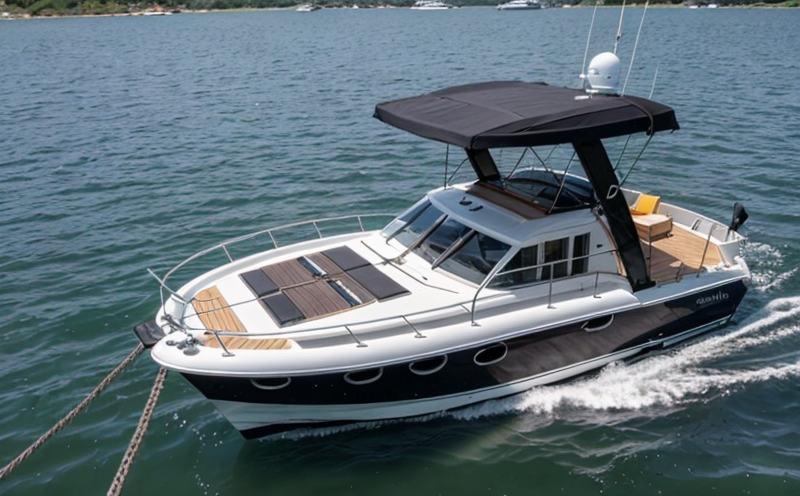ASTM G31 Immersion Corrosion Testing of Anchoring Materials
The ASTM G31 immersion corrosion testing method is a critical procedure used to evaluate the resistance of materials intended for mooring and anchoring in marine environments. This test simulates real-world conditions by exposing specimens to saltwater, which can lead to accelerated corrosion due to its high chloride content. Understanding material durability under such harsh conditions is essential for ensuring safety and longevity in maritime applications.
Marine structures like buoys, offshore platforms, and ships rely on robust mooring systems that must withstand the rigors of ocean environments. The immersion test follows stringent ASTM G31 standards, which specify detailed protocols for specimen preparation, testing procedures, and acceptance criteria. Compliance with these guidelines is mandatory for manufacturers seeking to ensure their products meet industry standards.
The testing process involves submerging a sample of anchoring material in a solution that closely mimics seawater. This solution typically contains sodium chloride (NaCl) at concentrations ranging from 30,000 ppm to 50,000 ppm, depending on the specific ASTM G31 variant used. The temperature is carefully controlled and maintained between 23°C ± 2°C for a duration of up to six months or longer, based on the test's requirements.
During the immersion period, various factors contribute to the corrosion process, including oxygen availability, pH levels, and microbial activity. These conditions are designed to replicate the natural environment where the anchoring materials will be deployed. After exposure, the samples undergo a thorough inspection for signs of corrosion such as pitting, cracking, or loss in mass.
The ASTM G31 test is widely recognized for its ability to predict long-term performance by simulating actual marine conditions. This makes it an indispensable tool for quality managers and compliance officers who need to verify that their products meet the rigorous demands set forth by industry standards. For R&D engineers, this method offers valuable insights into material behavior under extreme conditions, helping them develop more resilient materials.
By incorporating ASTM G31 immersion testing into their quality control processes, manufacturers can enhance product reliability and extend service life in challenging marine environments. This ensures that the equipment remains functional throughout its intended lifespan without compromising safety or operational efficiency.
- Customer Impact: Ensures long-term performance and durability of mooring and anchoring materials.
- Safety: Reduces risks associated with material failure in critical maritime applications.
- Cost Savings: Minimizes repair costs by selecting corrosion-resistant materials upfront.
- Market Competitiveness: Establishes a reputation for delivering high-quality, reliable products.
Why Choose This Test
Selecting ASTM G31 immersion corrosion testing as part of your quality assurance process offers numerous advantages that are particularly beneficial in the marine and ship equipment sector. Firstly, it provides a standardized approach to evaluating material resistance against chloride-induced corrosion—a common issue faced by materials used in maritime environments.
Standardization is crucial for ensuring consistency across different batches or suppliers of anchoring materials. By adhering to ASTM G31 guidelines, manufacturers can guarantee that their products meet the same stringent criteria regardless of origin. This not only enhances product reliability but also fosters trust among customers who value consistent quality.
The immersion test also allows for early detection of potential problems through continuous monitoring during the exposure period. Early identification helps in addressing issues before they escalate into costly failures or safety hazards. For procurement teams, this means more informed decisions about which suppliers to choose based on proven performance rather than just initial cost considerations.
In summary, choosing ASTM G31 immersion corrosion testing demonstrates a commitment to excellence and adherence to industry best practices. It supports sustainable business operations by reducing long-term costs while enhancing product integrity and customer satisfaction.
Customer Impact and Satisfaction
The implementation of ASTM G31 immersion corrosion testing has a profound impact on customer satisfaction and loyalty within the marine and ship equipment sector. By adhering to this rigorous testing protocol, manufacturers can deliver products that consistently meet or exceed expectations, thereby building long-term relationships with clients.
- Enhanced Trust: Consistent results from ASTM G31 tests instill confidence in customers regarding product reliability.
- Achieving Compliance: Meeting regulatory requirements enhances reputation and strengthens market position.
- Reduced Warranty Claims: Robust testing reduces instances of premature failure, leading to fewer warranty claims and improved customer experience.
- Increased Product Lifespan: Materials that pass ASTM G31 tests tend to have longer lifespans in harsh marine conditions, satisfying customers' needs for durable solutions.
In summary, the impact of ASTM G31 immersion corrosion testing extends beyond mere compliance—it shapes customer perceptions and fosters trust through consistent quality delivery. This ultimately translates into higher satisfaction levels and sustained business growth.
Competitive Advantage and Market Impact
The adoption of ASTM G31 immersion corrosion testing provides significant competitive advantages in the marine and ship equipment market. By incorporating this advanced testing method, companies can differentiate themselves by offering products that demonstrate superior durability and reliability under challenging environmental conditions.
Firstly, adherence to ASTM G31 ensures that manufacturers meet international standards recognized globally. This compliance translates into broader market acceptance and increased competitiveness in both domestic and export markets. Companies that lead the way in implementing such testing protocols are likely to gain a competitive edge over those who lag behind.
Secondly, consistent performance through rigorous testing builds brand reputation. Customers increasingly seek out brands known for delivering high-quality, reliable products. By consistently meeting or exceeding ASTM G31 requirements, companies can establish themselves as leaders in their field, attracting more business and building long-term relationships with satisfied customers.
Lastly, the ability to predict material behavior accurately through this testing method allows manufacturers to innovate faster and bring better products to market sooner. This agility enables them to stay ahead of competitors by continuously improving product offerings based on real-world performance data rather than relying solely on theoretical models.
In conclusion, embracing ASTM G31 immersion corrosion testing offers substantial benefits that extend far beyond individual company operations. It contributes positively towards overall industry advancement and helps maintain high standards for marine equipment worldwide.





